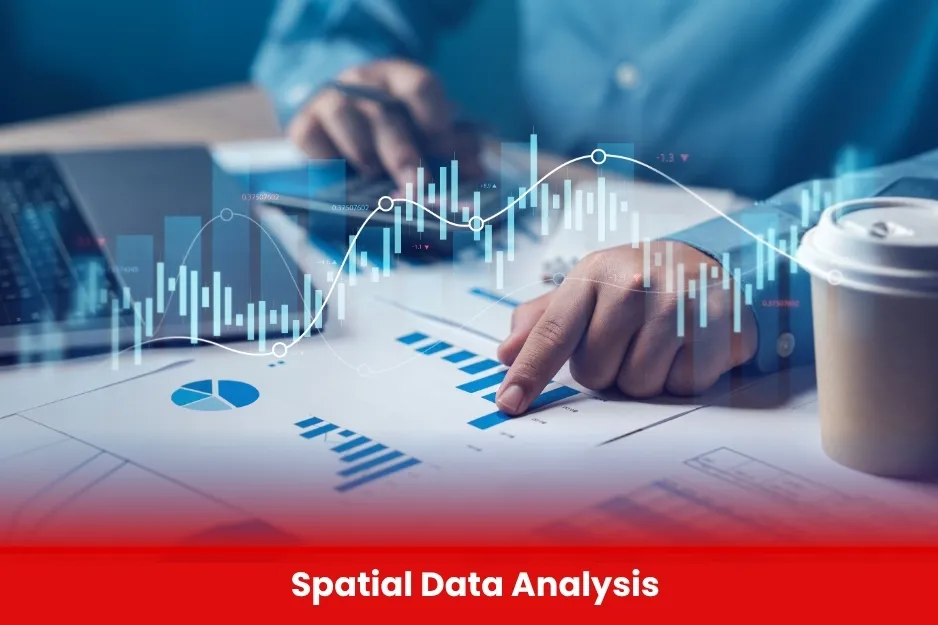Spatial Data Analysis
Spatial Data Analysis involves examining geographic data to uncover patterns and support decision-making. BURRAQ UK uses GIS, remote sensing, and modern tools to turn location-based data into actionable insights for planning, development, and environmental monitoring.

Aim of Spatial Data Analysis
To develop practical skills in analyzing and interpreting spatial data using modern GIS and remote sensing tools, enabling informed decision-making in planning, development, and environmental management.
Course Overview
Spatial Data Analysis
Total Modules 8
Training Credits 24
Directed Learning Hours (DLH) 120
Course Code BUK1698
- Diploma or degree in Geography, Geomatics, GIS, Surveying, Environmental Science, Civil Engineering, or related fields
- Basic understanding of mapping, coordinate systems, or spatial data concepts
- Familiarity with computers and data analysis tools
- Open to students, professionals, and researchers involved in geospatial or planning projects
| Course Code | Curriculum Title | Credit | DLH |
|---|---|---|---|
| BUK1698-1 | Introduction to Spatial Data Analysis | 4 | 20 |
| BUK1698-2 | Fundamentals of GIS | 4 | 20 |
| BUK1698-3 | Data Collection and Sources | 4 | 20 |
| BUK1698-4 | Spatial Analysis Techniques | 4 | 20 |
| BUK1698-5 | Raster Data Analysis | 4 | 20 |
| BUK1698-6 | Geostatistics and Spatial Modeling | 4 | 20 |
Module 1: Introduction to Spatial Data Analysis
- What is spatial data?
- Importance and applications in various fields
- Types of spatial data (vector, raster)
Module 2: Fundamentals of GIS
- Coordinate systems and map projections
- Spatial data models and formats
- Introduction to GIS software (e.g., QGIS, ArcGIS)
Module 3: Data Collection and Sources
- Satellite imagery, GPS, UAVs, and remote sensing
- Importing and managing geospatial datasets
- Data quality and metadata
Module 4: Spatial Analysis Techniques
- Buffering, overlay, and spatial queries
- Proximity and network analysis
- Terrain and surface analysis (DEM, slope, aspect)
Module 5: Raster Data Analysis
- Image classification (supervised/unsupervised)
- Change detection and land use mapping
- NDVI and environmental indices
Module 6: Geostatistics and Spatial Modeling
- Interpolation techniques (IDW, Kriging)
- Heatmaps and hotspot analysis
- Spatial pattern and cluster detection
Module 7: Visualization and Cartography
- Map design principles
- Thematic mapping and data presentation
- Creating effective spatial reports
Module 8: Real-World Project / Case StudyModule 8: Real-World Project / Case Study
- Hands-on spatial data analysis project
- Report preparation and presentation
- Use of open data and real case scenarios
- Students and Graduates of Geography, GIS, Surveying, Environmental Science, Urban Planning, or Civil Engineering
- Professionals working in mapping, urban development, environmental monitoring, or disaster management
- GIS Analysts, Remote Sensing Specialists, and Survey Technicians
- Researchers and academics handling spatial or environmental data
- Anyone with basic computer skills and interest in spatial technologies
- All Modules within this qualification are assessed internally by the approved training Centre and externally verified by BURRAQ UK. The program uses a criterion-referenced assessment approach to ensure that learners successfully meet all required learning outcomes.
- A Pass in any unit is granted only when the learner submits valid, reliable, and authentic evidence that demonstrates achievement of the assessment criteria. The Assessor is responsible for reviewing this evidence and confirming that the learner has attained the expected standard.
- To guarantee fairness, transparency, and consistency, assessors are required to maintain a detailed audit record, clearly documenting the basis of their assessment decisions in line with quality assurance requirements.
